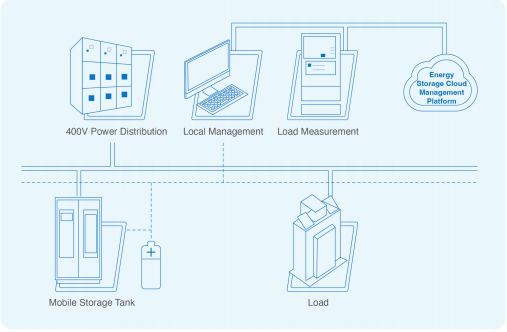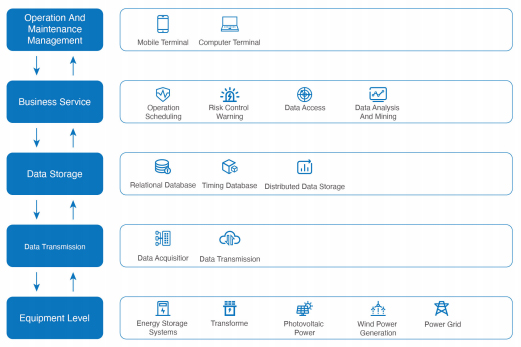
Th8 . 23, 2025 01:00 Back to list
Boost Efficiency with Smart EMS & Energy Management Systems
Optimizing Industrial Operations with Advanced Energy Management Systems
In an era defined by fluctuating energy costs, stringent environmental regulations, and the imperative for operational efficiency, the strategic deployment of an ems, or energy management system, has become paramount for industrial and commercial entities. An ems integrates sophisticated hardware and software solutions to monitor, control, and optimize energy consumption across various assets and facilities. This not only drives significant cost savings and operational stability but also enhances sustainability credentials and ensures compliance with evolving grid demands. As industries pivot towards decarbonization and smart infrastructure, the demand for sophisticated ems solutions is escalating rapidly, positioning them as a cornerstone of future energy ecosystems.
The global energy management system market is projected to grow from USD 27.2 billion in 2023 to USD 60.1 billion by 2028, at a Compound Annual Growth Rate (CAGR) of 17.2%, driven by increasing smart grid deployments and industrial IoT adoption (MarketsandMarkets). This growth underscores a widespread industry recognition of the critical role an energy management system plays in achieving operational excellence and environmental compliance. Key trends include the integration of artificial intelligence (AI) and machine learning (ML) for predictive energy analytics, the proliferation of distributed energy resources (DERs) requiring advanced orchestration, and the growing focus on demand-side management to balance supply and consumption dynamically. Furthermore, the collaboration between energy storage battery companies and energy management system providers is creating synergistic solutions that enable greater grid resilience and renewable energy integration.
Technical Specifications of a High-Performance EMS
A robust ems is characterized by its ability to provide granular control, real-time data acquisition, and intelligent decision-making capabilities. The technical architecture typically comprises a network of sensors, smart meters, data loggers, secure communication modules, and a central software platform. The system's effectiveness hinges on its precision in measurement, accuracy in forecasting, and responsiveness in control actions, crucial for optimizing complex industrial processes. Below are critical parameters and typical specifications for an advanced energy management system deployed in demanding industrial environments.
Key EMS Technical Parameters

The Manufacturing Process of a Robust Energy Management System (EMS)
The development and manufacturing of a reliable ems involves a meticulous process encompassing advanced engineering, precision manufacturing, and rigorous multi-stage testing. This comprehensive approach ensures that the final product meets the high demands of industrial applications in terms of durability, accuracy, and operational lifespan. Our unwavering commitment to quality materials, certified processes, and adherence to international standards is fundamental to delivering superior energy management system solutions capable of performing in the most challenging environments.
Detailed EMS Manufacturing Process Flow
- 1. Design and Engineering: Initial conceptualization and detailed system design, focusing on modularity, scalability, and compatibility with various industrial protocols. This phase leverages advanced CAD/CAM software for optimal component layout, thermal management, and structural integrity of embedded hardware. Critical material selection involves industrial-grade polymers and corrosion-resistant alloys for sensor components and enclosures to ensure longevity in harsh environments.
- 2. Component Sourcing and IQC: Procurement of high-quality electronic components, sophisticated sensors, and communication modules from globally certified suppliers. Each component undergoes strict Incoming Quality Control (IQC) procedures to verify specifications, performance, and compliance with environmental directives such as RoHS (Restriction of Hazardous Substances) and REACH (Registration, Evaluation, Authorisation and Restriction of Chemicals).
- 3. PCB Fabrication and Assembly: Manufacturing of Printed Circuit Boards (PCBs) utilizes automated Surface-Mount Technology (SMT) and precise Through-Hole Assembly processes. This ensures exact component placement and robust solder joints, critical for long-term reliability. Advanced inspection methods, including Automated Optical Inspection (AOI) and X-ray inspection, are employed to detect any microscopic manufacturing defects.
- 4. Enclosure Manufacturing: Production of highly durable and protective enclosures using specialized manufacturing techniques. For industrial energy management system units, materials such as robust aluminum alloys (e.g., Al-6061) or advanced engineering plastics are chosen for their exceptional strength, thermal properties, and environmental resistance. Manufacturing processes include precision CNC machining for intricate cuts and finishes, and often involve specialized surface treatments like powder coating or anodizing to enhance corrosion resistance, UV stability, and electromagnetic shielding.
- 5. System Integration and Firmware Flashing: Meticulous integration of PCBs, power supply units, communication interfaces, and other hardware into the final enclosure. Firmware, which constitutes the core operational logic of the energy management system, is then securely flashed onto the microcontrollers. This step ensures all hardware and low-level software interact seamlessly.
- 6. Calibration and Functional Testing: Every energy management system unit undergoes comprehensive calibration for its sensing elements (e.g., current, voltage, temperature, power quality sensors) against certified industry standards. Full functional testing rigorously validates all communication protocols, data acquisition capabilities, control outputs, and alarm functionalities. This includes stress testing under varying operational loads to simulate real-world conditions.
- 7. Environmental and Durability Testing: Products are subjected to stringent environmental tests to ensure resilience and longevity. These include temperature cycling, humidity exposure, vibration, shock resistance, and Ingress Protection (IP) testing, ensuring compliance with standards such as IEC 60068 (Environmental Testing) and NEMA 4X (for industrial enclosures, demonstrating exceptional corrosion resistance and water/dust proofing).
- 8. Software Development and Integration: Ongoing development and continuous refinement of the energy management system software platform. This encompasses designing intuitive user interfaces, developing powerful analytics engines, and ensuring seamless integration with existing IT infrastructure, SCADA systems, and enterprise resource planning (ERP) platforms. Agile methodologies and Continuous Integration/Continuous Deployment (CI/CD) practices are employed for robust software updates.
- 9. Final Quality Assurance and Packaging: A comprehensive final quality inspection is performed before packaging, ensuring all specifications are met, documentation is complete, and accessories are included. Products adhere to ISO 9001 quality management standards and relevant ANSI/NEMA standards for electrical enclosures. The typical service life of our industrial energy management system hardware components is engineered for 10-15 years, with continuous software updates provided throughout its operational lifespan to ensure long-term performance and relevance.

Application Scenarios and Industry Benefits of EMS
The versatility of an ems makes it indispensable across a multitude of industries, each leveraging its capabilities to address unique energy challenges. From heavy manufacturing to critical infrastructure, the core benefit remains consistent: optimized energy use leading to substantial savings and enhanced operational resilience. The target industries for our energy management system solutions include, but are not limited to, petrochemical, metallurgy, water supply & drainage, automotive manufacturing, data centers, and large commercial facilities.
Typical Application Scenarios:
- Petrochemical Plants: Continuous monitoring of high-energy processes (e.g., distillation, cracking, pumping) to identify inefficiencies and potential leakages. An energy management system facilitates intelligent load shedding during peak demand periods and optimizes energy consumption of motors, pumps, and heaters, leading to up to 15-20% energy savings. The robust, corrosion-resistant design ensures a long service life and reliable data acquisition in harsh, chemically aggressive environments.
- Metallurgy and Steel Mills: Precise management of power-intensive equipment such as electric arc furnaces, induction heaters, rolling mills, and associated auxiliary systems. An energy management system enables accurate control over instantaneous power demand, significantly reducing maximum demand charges and improving overall power factor correction. Real-time data and predictive analytics help in identifying equipment inefficiencies, preventing unplanned downtime, and optimizing production schedules.
- Water Supply & Drainage Systems: Optimization of large-scale pump schedules based on granular demand forecasts, dynamic electricity tariffs, and reservoir levels. An energy management system can reduce pumping costs by 10-25% by intelligently operating pumps during off-peak hours and ensuring efficient flow management. The system's ability to seamlessly integrate with legacy SCADA and Supervisory Control systems is crucial for maintaining operational continuity and extending asset life.
- Data Centers: Comprehensive monitoring and optimization of Power Usage Effectiveness (PUE) by intelligently managing HVAC systems, server racks, Uninterruptible Power Supplies (UPS), and power distribution units. An energy management system ensures maximum uptime and optimal operating conditions while minimizing cooling and power consumption, crucial for facilities with immense energy footprints. Advanced analytics can predict potential thermal or electrical overloads, averting costly outages.
- Commercial Buildings and Campuses: Integrated control of lighting, HVAC, and plug loads across multi-building facilities. An energy management system platform enables active participation in demand response programs, facilitates accurate tenant energy billing, and simplifies compliance with green building certifications, thereby enhancing property value, occupant comfort, and reducing operational expenditure.
These deployments consistently demonstrate measurable advantages, including significant energy savings, enhanced operational stability, substantial reductions in carbon footprint, and prolonged equipment life due to optimized operating conditions and proactive maintenance. Our solutions are specifically designed for longevity, offering exceptional corrosion resistance and reliability in even the most challenging industrial settings, thus minimizing total cost of ownership and maintenance overheads.
Technical Advantages of Our EMS Solutions
Our ems stands apart due to its blend of cutting-edge technology, robust engineering, and user-centric design. We provide comprehensive solutions that not only meet current industry demands but are also future-proof, adaptable to evolving energy landscapes, technological advancements, and stringent regulatory changes. The key technical advantages that differentiate our energy management system solutions include:
- Advanced Predictive Analytics & AI: Leveraging sophisticated AI and Machine Learning (ML) algorithms, our energy management system can forecast energy demand, predict equipment failures, and optimize energy supply (including renewable sources) with exceptional accuracy. This capability enables proactive optimization strategies, minimizing reliance on static historical data patterns and dynamically adapting to real-time changes in energy markets and operational conditions.
- Seamless Integration Capabilities: Engineered for maximum interoperability, our energy management system supports a broad spectrum of open and proprietary industrial communication protocols (Modbus TCP/RTU, OPC UA, BACnet/IP, MQTT, DNP3, custom APIs). This ensures effortless and secure integration with existing SCADA, BMS (Building Management Systems), ERP systems, and diverse energy assets, including those from various energy storage battery companies and renewable energy generators.
- Modular and Scalable Architecture: Our energy management system is built on a highly modular and flexible framework, allowing for effortless expansion and deep customization. Clients can initiate their journey with essential energy monitoring features and seamlessly scale up to advanced control, sophisticated demand response programs, multi-site management, and complex renewable energy integration as their operational needs and strategic objectives evolve.
- Robust Cybersecurity Measures: Recognizing the criticality and vulnerability of energy infrastructure, our energy management system incorporates multi-layered and industry-leading security protocols. These include end-to-end data encryption (TLS 1.2+), stringent role-based access control (RBAC), secure boot mechanisms, and adherence to international cybersecurity standards such as IEC 62443 and ISO 27001, providing comprehensive protection against cyber threats.
- High Reliability and Redundancy: Our energy management system hardware components are meticulously engineered for continuous operation in the most demanding industrial environments, boasting extended Mean Time Between Failures (MTBF) figures. Critical system components feature built-in redundancy, along with redundant communication paths and robust data backup systems, ensuring exceptional system resilience, data integrity, and uninterrupted operational performance.
- Intuitive User Experience and Advanced Visualization: The energy management system software platform features highly customizable, intuitive dashboards, real-time data visualization tools, and actionable insights. This empowers operators and decision-makers to gain profound understanding of energy patterns, identify anomalies, and make informed decisions swiftly and efficiently, minimizing the learning curve and maximizing operational effectiveness.
Vendor Comparison: Differentiating EMS Solutions
Choosing the right ems provider is a strategic decision that profoundly impacts long-term operational efficiency, financial performance, and environmental compliance. While numerous providers offer energy management system solutions, key differentiators often lie in their technological depth, customization capabilities, robustness, and comprehensive post-deployment support. Below is a comparative overview highlighting critical factors for consideration when evaluating various energy management system vendors, positioning our solution against typical industry offerings.
Key EMS Vendor Comparison Criteria
Customized EMS Solutions and Tailored Implementations
Recognizing that no two industrial operations are identical, our approach to ems deployment is centered around deep customization and a consultative partnership. We collaborate closely with clients to understand their unique energy profiles, operational constraints, existing infrastructure, and strategic business objectives. This in-depth analysis ensures that the implemented energy management system is not merely a product, but a bespoke solution perfectly aligned with their specific goals, whether it’s maximizing energy cost reduction, achieving stringent environmental compliance, or seamlessly integrating diverse renewable energy sources and assets from various energy storage battery companies.
Our customization capabilities extend comprehensively, from hardware modifications designed for specific environmental conditions (e.g., extreme temperatures, high humidity, corrosive atmospheres) to bespoke software modules developed for unique process optimization challenges. This includes developing custom dashboards and analytical reports tailored to specific key performance indicators (KPIs), ensuring seamless integration with proprietary Enterprise Resource Planning (ERP) systems, Manufacturing Execution Systems (MES), and designing advanced control logic for highly complex industrial processes. Our multidisciplinary team of experienced engineers, data scientists, and project managers works diligently to deliver an energy management system that grows intelligently with your business, providing enduring value and adaptability to future changes.

Real-World Application Case Studies
Our extensive track record of successful energy management system deployments across diverse industrial sectors underscores our proven expertise and the tangible, measurable benefits our solutions consistently deliver. These real-world examples highlight how our advanced energy management system has transformed client operations, leading to significant efficiencies and strategic advantages.
Case Study 1: Large-Scale Petrochemical Complex
- Challenge: The client faced volatile energy costs, substantial peak demand charges, and an outdated legacy monitoring system that contributed to significant energy inefficiencies across multiple complex processing units. The harsh operating environment also demanded highly robust and reliable equipment.
- Solution: We implemented a comprehensive energy management system, integrating over 500 smart meters, specialized sensors, and control points across the expansive petrochemical complex. The system provided real-time, granular energy flow visualization, advanced demand forecasting with AI, and automated, rule-based load-shedding capabilities to mitigate peak charges. Its industrial-grade hardware, including NEMA 4X enclosures, ensured resilience.
- Result: The client achieved a remarkable 17% reduction in overall energy consumption within the first year of operation, resulting in annual energy cost savings exceeding $2.5 million. Peak demand charges were reduced by 22%, and the system's predictive maintenance alerts for high-consumption assets extended equipment lifespan by an estimated 10%. Customer feedback specifically highlighted the intuitive user interface, seamless integration with existing SCADA infrastructure, and the exceptional corrosion resistance of the hardware as key strengths.
Case Study 2: Municipal Water Treatment Facility
- Challenge: The municipal facility grappled with exceptionally high electricity consumption from its large pump arrays, particularly during expensive peak tariff periods. Balancing fluctuating water demand with dynamic energy costs and maintaining uninterrupted service posed a significant operational hurdle.
- Solution: We deployed a specialized energy management system specifically tailored for water utilities, integrating seamlessly with reservoir levels, real-time flow rates, and dynamic electricity pricing signals. The system automated pump scheduling to intelligently operate primarily during off-peak hours and optimized pump speeds based on predictive water demand, ensuring both efficiency and service continuity.
- Result: The facility achieved a substantial 28% reduction in pumping energy costs, amounting to over $1.2 million in annual savings. The energy management system's ability to provide granular control over the pumping infrastructure significantly improved operational flexibility and substantially lowered the facility's overall carbon footprint. The client particularly praised the system's robust construction and inherent corrosion resistance in the damp and chemically treated environment, alongside its long service life, which collectively contributed to a low total cost of ownership.
Ensuring Trust and Support: FAQ, Lead Time, Warranty & After-Sales
At the core of our service philosophy is an unwavering commitment to transparency, reliability, and unparalleled customer support. We understand that investing in an energy management system is a significant strategic decision, and we strive to provide complete peace of mind through every stage of our partnership, from initial consultation to long-term operation.
Frequently Asked Questions (FAQ)
- Q: What is the typical implementation timeline for an energy management system?
- A: Implementation timelines vary significantly based on the complexity, scale, and specific customization requirements of the project. For a standard industrial energy management system, the process typically ranges from 8 to 16 weeks, which includes a detailed site assessment, customized hardware installation, comprehensive software configuration, rigorous testing, and thorough operator training. Larger, more integrated, or highly customized deployments may require additional time, which will be clearly outlined in your project plan.
- Q: Is your energy management system compatible with existing infrastructure and legacy systems?
- A: Yes, our energy management system is meticulously designed for maximum interoperability and seamless integration. We support an extensive array of industrial communication protocols (Modbus TCP/RTU, OPC UA, BACnet/IP, MQTT, DNP3) and are engineered to integrate effortlessly with most legacy SCADA, BMS, and process control systems. A detailed, on-site infrastructure assessment will be conducted to confirm specific compatibility requirements and design the optimal integration strategy for your facility.
- Q: How do you ensure the security and privacy of sensitive energy data?
- A: Data security and privacy are paramount and embedded into every layer of our energy management system. We employ robust end-to-end encryption (TLS 1.2+ for data in transit and encryption at rest) for all data transmission and storage, adhere strictly to ISO 27001 standards for information security management, and implement a multi-faceted role-based access control (RBAC) system. Regular third-party security audits, penetration testing, and continuous software updates are performed to proactively protect against emerging cyber threats and ensure data integrity.
- Q: Can the energy management system assist with regulatory compliance and reporting?
- A: Absolutely. Our energy management system provides comprehensive and highly customizable reporting features that significantly simplify compliance with various energy efficiency mandates, carbon emissions targets, and other environmental regulations. It offers fully auditable data trails, detailed consumption analytics, and pre-configured report templates designed to meet specific regulatory submission requirements, streamlining your compliance efforts.
Lead Time and Fulfillment
Our optimized global supply chain and highly efficient manufacturing processes ensure prompt and reliable fulfillment. Standard energy management system hardware components are typically available with a lead time of 4-6 weeks from confirmed order placement. For highly customized solutions or exceptionally large-scale deployments, the lead time may range from 8-12 weeks, depending on the complexity of unique fabrication, specific component sourcing, and intricate integration requirements. We provide a detailed and transparent project timeline upon proposal acceptance, ensuring clarity and predictability for our clients.
Warranty Commitments
We stand firmly by the superior quality, exceptional durability, and robust performance of our energy management system solutions. All hardware components come with a standard 3-year warranty covering manufacturing defects and operational failures under normal use conditions. For enhanced assurance and tailored support, extended warranty options and comprehensive Service Level Agreements (SLAs) are readily available, designed to meet your specific operational needs and long-term investment protection requirements.
Customer Support and After-Sales Service
Our unwavering commitment to our clients extends far beyond the initial installation. We offer comprehensive, multi-tiered after-sales support, including 24/7 technical assistance from certified experts, proactive remote monitoring of system health, and scheduled on-site maintenance services. Our dedicated support team is exceptionally equipped to swiftly troubleshoot any issues, provide timely software updates, and offer ongoing training to ensure that your team maximizes the long-term value and operational benefits of your energy management system. Regular system health checks, performance reviews, and consultative guidance are integral components of our standard service offerings, ensuring optimal, continuous performance.
Authoritative References
- MarketsandMarkets. "Energy Management System Market - Global Forecast to 2028." Published October 2023.
- International Electrotechnical Commission (IEC). IEC 62053-22: Electricity metering equipment (a.c.) – Particular requirements – Part 22: Static meters for active energy (classes 0,1 S, 0,2 S and 0,5 S).
- International Organization for Standardization (ISO). ISO 9001: Quality management systems – Requirements.
- International Organization for Standardization (ISO). ISO/IEC 27001: Information security management, cybersecurity and privacy protection – Information security management systems – Requirements.
- National Electrical Manufacturers Association (NEMA). NEMA 250: Enclosures for Electrical Equipment (1000 Volts Maximum).
- International Electrotechnical Commission (IEC). IEC 60068: Environmental testing.
-
Boost Efficiency with Smart EMS & Energy Management Systems
NewsAug.23,2025
-
Smart Energy Management System | Save Costs & Boost Efficiency
NewsAug.22,2025
-
Advanced Energy Management Systems: Optimize & Save Costs
NewsAug.19,2025
-
Smart Energy Management System: Control & Monitor Usage
NewsAug.18,2025
-
EMS for Advanced Energy Management & Storage
NewsAug.17,2025
-
Boost Efficiency with Smart EMS Energy Management Systems
NewsAug.16,2025


